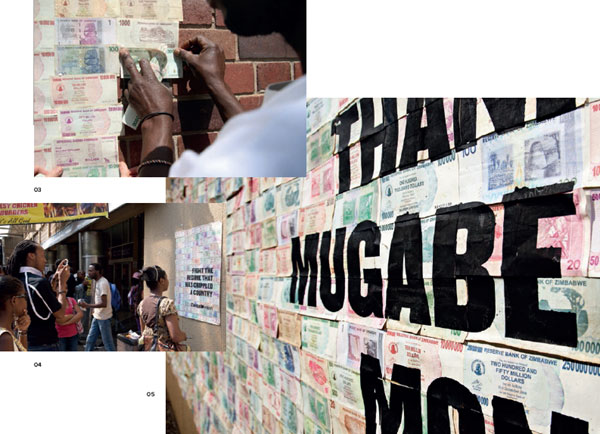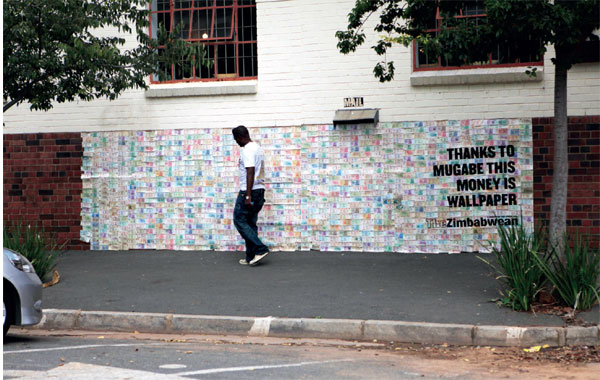The Zimbabwean
The Trillion Dollar Campaign
TBWAHuntLascaris
Every now and then an advertising campaign becomes news. For modern ad agencies, having a piece of advertising picked up by the mainstream media can be a holy grail, giving a brand massive coverage at a very low cost. It’s a risky strategy to intentionally embark on, however – newspapers and magazines can be fickle and unpredictable beasts, and a story that may seem perfectly constructed back at the agency can be simply ignored when released into the world, or worse, heavily criticised in the press for all to see. But come up with an approach that works, and your campaign will be discussed by journalists and bloggers all over the world.
TBWAHuntLascaris in Johannesburg achieved one such media breakthrough with its unusual outdoor ad campaign for The Zimbabwean newspaper.
The newspaper is produced by a group of exiled Zimbabwean journalists, and sold in South Africa, the UK and Zimbabwe. On entering its home country, however, it is charged an import duty of 55 per cent, rendering the paper unaffordable to the average Zimbabwean. The newspaper wanted to draw attention to this, and raise awareness of the newspaper generally, so approached TBWAHuntLascaris for help.
‘The Zimbabwean approached us for a campaign to boost sales and subscriptions,’ explain the creative team on the campaign, which consisted of copywriters Raphael Basckin and Nicholas Hulley, and art directors Shelley Smoler and Nadja Lossgott. ‘The business was being aggressively targeted by a despotic government, and the “luxury tax” the Mugabe regime had imposed was making life incredibly difficult for them to operate and deliver the news. We needed to come up with a campaign that raised awareness quickly and powerfully for the paper that simultaneously told people about the plight of the paper, and the plight of freedom of speech in Zimbabwe.’
The creatives came up with an ingenious solution – to create a series of wall murals, billboards and flyers out of real Zimbabwean banknotes, specifically the Z$100 trillion dollar note, which had become a symbol of the country’s world-record inflation. Despite its enormous face value, the note was in fact worth less than paper, so TBWAHuntLascaris turned it into advertising. ‘Their media budget was limited, because their operating costs had soared on account of having to subsidize their own distribution,’ continue the creatives, ‘and also because [Zimbabwe’s ruling party] ZANU-PF had run the economy into the ground – people were buying their newspaper with money that had become worthless before the next edition was released. We realized that the most succinct thing we could do was to use their worthless money to break through to consumers about the situation in Zimbabwe and the fearlessness of The Zimbabwean in reporting it.’
‘We realized that the most succinct thing we could do was to use their worthless money to break through to consumers about the situation in Zimbabwe and the fearlessness of The Zimbabwean in reporting it.’
01 Flyers distributed as part of the Trillion Dollar Campaign, made from real Zimbabwean bank notes stamped with the campaign’s message.

02 Billboard advertisement for The Zimbabwean newspaper on display in Johannesburg. The ad is made of hundreds of defunct Zimbabwean bank notes.

03 A member of the team sticks the bank notes to a wall for another of the ads.
04-05 Members of the public read and photograph one of the ads on the streets of Johnannesburg.

06-09 The ad creatives used a grid to create the posters of money, and the notes were stuck together using tape. The flyers – made of individual bank notes – were all stamped by hand.




10-13 Examples of the finished posters, displayed on walls in Johannesburg. While it only ran locally, the campaign drew huge attention in the media, and was covered in newspapers and blogs across the world.
The client loved the idea. ‘Our clients are brave people,’ say the creatives. ‘They’ve been persecuted and forced into exile for reporting the news. And they are resourceful – managing to keep a paper alive under extreme conditions. So they were very excited and not the least bit fazed by our idea.’
To accumulate enough money to create the various ads, Basckin, Hulley, Smoler and Lossgott called everyone they knew. ‘We took to the streets, scoured our phonebooks for Zimbabweans, met people in gloomy parking lots… but the reality is, Jo’burg is awash with this defunct currency. We just had to gather it up.’ This low-fi approach to the campaign was continued in the making of the posters, with everything made by hand – ‘we literally stuck all the notes together,’ say the team. Once the posters were finished, a printmaker silkscreened a simple message on top of the notes, which proclaimed ‘Thanks to Mugabe this money is wallpaper’, above The Zimbabwean logo. Flyers made of single notes printed with the same slogan were also distributed around Johannesburg.
‘Our clients have been persecuted and forced into exile for reporting the news, so they were very excited and not the least bit fazed by our idea.’
Unsurprisingly, the campaign caused a stir. And, despite only being displayed locally in Johannesburg, news of the billboard and flyers spread rapidly around the globe. ‘Our campaign became the news,’ say the team, simply. ‘We’ve been reported on in the traditional media all around the world, as well as extensively on the web. In fact, we even received footage of one of our posters being displayed in South Korea (we have no idea how it got there). In terms of the public reaction, we have evidence of a massive surge in visits to the website and a strong increase in revenue and sales. Anecdotally, there is strong evidence that it caught the public’s imagination having been told about the campaign from the unlikeliest sources.’
In many ways, The Trillion Dollar Campaign was a very simple idea, despite the unusual materials that were employed in its creation. The art direction was minimal but striking, and its message was clear and direct. This transparency of approach contributed to the campaign becoming a significant news story, capturing the imagination of editors and bloggers alike. What began as a local, fairly low-key ad campaign was therefore spread all over the world, giving The Zimbabwean coverage and attention that could never have been bought.


